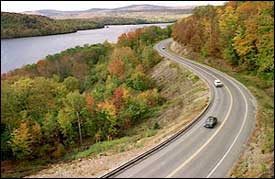















Successes in Stewardship: October 2002 |
|---|

|
Federal Highway Administration
October 2002
More than a Philosophy: Maine's Integrated Transportation Decision Making Process

Route 201 during the fall season in Maine (Maine DOT image)
The Integrated Transportation Decision Making (ITD) Process in Maine incorporates environmental considerations into the entire transportation process, from planning to maintenance. Developed by the Maine Department of Transportation (MDOT), ITD integrates the decision making processes of Maine's Sensible Transportation Policy Act, the National Environmental Policy Act (NEPA), and Section 404 of the Clean Water Act. Rather than sequential processes, review activities are concurrent, and documentation and record keeping are consolidated. As a result, both time and resources are saved. For example, the national median time for completing an Environmental Impact Statement (EIS) for a major transportation project is 54 months. In 2002, MDOT was able to complete a concise EIS for the Augusta River Crossing Project in 41 months.
|
Benefits of
|
ITD provides MDOT and its partners with practical approaches and tools they can use to balance transportation infrastructure development with protection of the environment and community values. The overall goals of ITD are to:
|
MDOT and the FHWA Maine Division used the Mid-Atlantic Transportation and Environment Streamlining Framework as a model to develop a ten-step process to improve stakeholder coordination. Part of the ITD process, the ten-step process outlines agency responsibilities, expectations, and concurrence points for achieving process efficiences from planning to project implementation. The ten-step process has helped improve interagency coordination in Maine by bringing agency partners to the table early to identify and analyze impacts and to define upfront project purpose and need. As working relationships built on trust have developed, resource agencies have become more comfortable in getting involved early, improving the integration process.
|
Project Background MDOT had already been moving in the direction of environmental stewardship and early consideration of environmental issues prior to the implementation of ITD. In 1989, MDOT began monthly meetings with state and Federal regulatory and resource agencies to discuss permitting issues. These interagency meetings soon expanded to include discussions on integrating NEPA from project planning through construction and on fostering environmental streamlining. With the passage of Maine's Sensible Transportation Policy Act in 1991, MDOT strengthened its public involvement process by developing seven regional transportation advisory committees and more focused public advisory committees for all major projects. In 1998, senior MDOT managers met with FHWA Headquarters staff to discuss streamlining opportunities. Soon after, a restructuring of MDOT's Environmental Office merged selected functions into the Bureau of Planning and placed regional environmental coordinators into the Bureau of Maintenance and Operations. Restructuring allowed MDOT to integrate processes and focus on streamlining and stewardship opportunities. MDOT then partnered with the FHWA Maine Division to develop ITD and its associated guidance, staff training, and public outreach. |
|
Interagency communication will be further enhanced as MDOT and the FHWA Maine Division allow other partners to use MDOT's ITD database, which facilitates the consideration of environmental factors during the development of six year plans, STIPs, and project development activities. The ITD database is part of MDOT's larger ProjEx system, which tracks projects by NEPA category (EIS, Environmental Assessment, or Categorical Exclusion.) The ITD database integrates project data, improves impact analyses, and helps identify potential "fatal flaws" that could delay or derail projects.
Future work in Maine will include integrating context sensitive solutions and the Section 106 and Section 4(f) processes into ITD in order to further streamline the process and better address local community needs. MDOT also hopes to expand its use of innovative tools such as Geographic Information Systems technology.
Contact InformationDuane A. Scott, Program Manager |
FHWA-AASHTO Environmental Stewardship Demonstration ProjectsTwenty-two states have registered environmental stewardship demonstrations, including Maine. To learn more about these projects, visit: http://www.itre.ncsu.edu/aashto/stewardship/projects.asp |
For more information on environmental streamlining, please visit: www.fhwa.dot.gov/environment/strmlng/index.asp.
"Successes in Stewardship" is a Federal Highway Administration newsletter highlighting current environmental streamlining practices from around the country. To subscribe, contact Cassandra Allwell at (617) 494-3997 or allwell@volpe.dot.gov.
